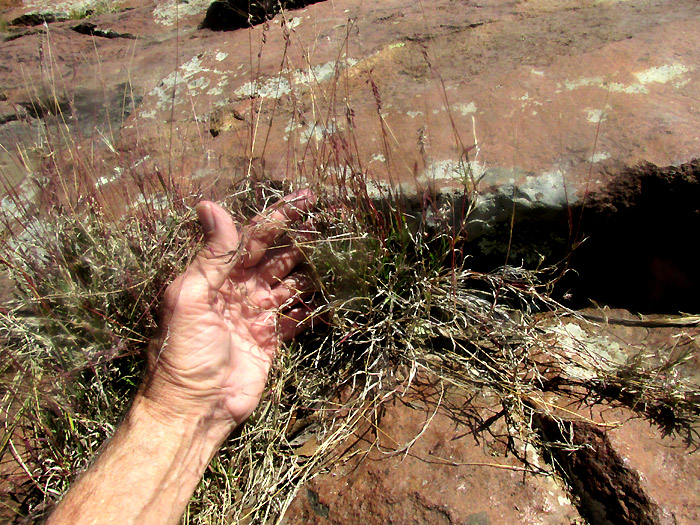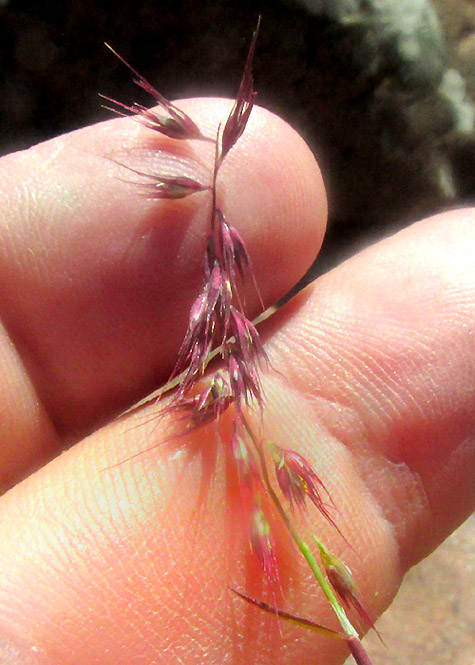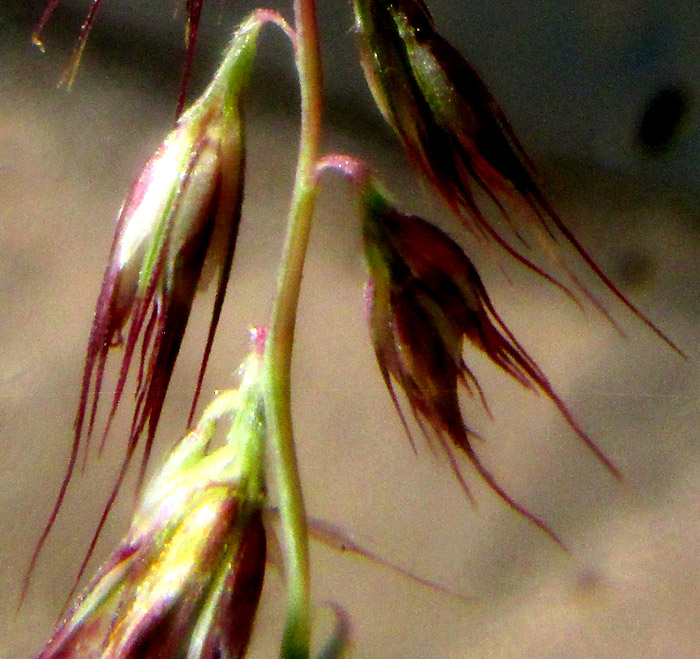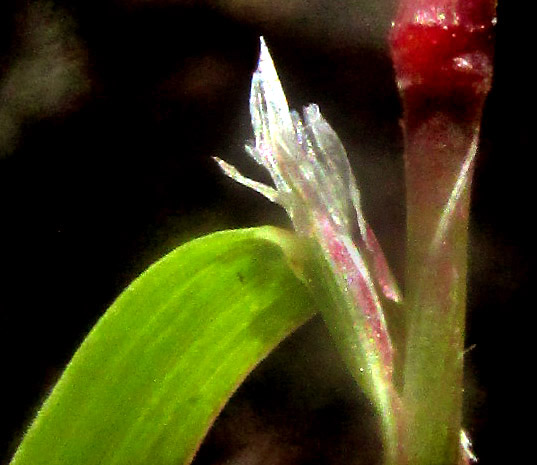Excerpts from Jim Conrad's
Naturalist Newsletter
Entry dated November 7, 2023, from notes taken at Cascadas de La Piedad waterfall 3kms NW of the community of San Pablo, municipality of Almeaco de Bonfil; bedrock of igneous andesite; N20.1008°, W100.0041°, elevation 2360 meters (7750ft); extreme southern Querétaro state, MÉXICO
BOUTELOUA PURPUREA

Even during the ongoing two-year dry period classified by the "North American Drought Monitor" as an extreme D3 drought, a small stream of clear, cold water meandered across a livestock-grazed meadow atop a bed of pinkish, igneous andesite rock. Just before tumbling over a high ledge to create the picturesque Cascada de La Piedad, or Piety Waterfall, the above scraggly looking grass was rooted in a crack in the sometimes flood-scoured andesite stream bed. The grass's attention-catching feature was that it produced long stolons lying atop the rock, spreading away from the main clump. I couldn't recall seeing a grass with such slender flower clusters topping their stems, combined with such long stolons.

Up close, the grass's inflorescences of down-curved clusters of spikelets with parts tipped with slender, needlelike awns were very similar to those seen on the famous Sideoats Grama, an important component of short-grass prairies throughout the Americas from Canada to Argentina; it's the State Grass of Texas. I've seen many Sideoats Grama plants, but never with such long, conspicuous stolons. Surely this was another grama grass species, genus Bouteloua.

The spikelets were hairless.

Ligules at the leaves' bases, where the blades met the stems, were membranous, and irregularly incised, or lacerated.
In this part of highland central Mexico about 14 grama grass species have been documented. Of all the 14 species, only three taxa are described as producing stolons.
Of those three species, Yolanda Herrera Arrieta in her 1998 study "Estudio biosistemático del género Bouteloua (Poaceae) en México" describes the ligula of Bouteloua pedicellata as consisting of a dense ring of hairs 0.5-0.8mm long -- un anillo denso de pelos de 0.5 a 0.8 mm de longitud, while our grass's ligula is much taller and membranous. The two remaining stoloniferous taxa consist of a variety of the aforementioned abundant Sideoats Grama, and a species narrowly endemic and described as rare by Herrera Arrieta, one found only in the highlands of the central Mexican states of Guanajuato, Hidalgo, Michoacán, Morelos and here in Querétaro, and that's Bouteloua purpurea.
According to Herrera Arrieta, the only single feature consistently separating the rare Bouteloua purpurea from the abundant and widely distributed Bouteloua curtipendula is that the anthers of Bouteloua purpurea are purple, while in Bouteloua curtipendula, if the anthers are purple, the plants don't produce stolons. Our mature plants are far beyond the anther-producing stage, so apparently there's no single, non-overlapping, available trait shown by our streamside plants which can be use to determine which of the two taxa it is.
Therefore, I take the gestalt approach, forming an impression based on overall impressions of the two candidate taxa's several overlapping features.
The 2010 digital edition of the Flora fanerogámica del Valle de México by Graciela and Jerzy Rzedowski describes the inflorescences of Bouteloua curtipendula as bearing (12)20-40(80) clusters of spikelets along their sides, while those of Bouteloua purpurea develop (3)5-15, so there's a vote for our plants averaging about 12 being Bouteloua purpurea. The Rzedowskis further say that after reviewing plenty of specimens of Bouteloua curtipendula from our area, they find no evidence that the the species' two varieties should be maintained -- they intergrade too much. With that in mind, Bouteloua curtipendula is described as reaching 1m tall (3.3ft), while Bouteloua purpurea reaches only 50(70) cm (20{27} inches). That's another vote for our short Bouteloua curtipendula.
Moreover, the literature doesn't say how long stolons of Bouteloua curtipendula may grow, while stolons of Bouteloua purpurea are described as up to one meter long (3.3ft). That gives the impression that if Bouteloua curtipendula produces stolons, they're not conspicuously long, while those of Bouteloua purpurea certainly are. At this point my gestalt impression becomes that here surely we have the rare and narrowly endemic BOUTELOUA PURPUREA, with no English name.
Bouteloua purpurea is described as growing in deep, fertile or rocky soils, between 1800 and 2300 meters in elevation (5900-7550ft) -- habitats broadly overlapping those of Bouteloua curtipendula. In fact, so many features of the two taxa overlap that I wonder whether anther color is enough to separate the two taxa, particularly with Bouteloua curtipendula being such a variable species.
Bouteloua purpurea is so rare and overlooked that nothing is found about its uses by humans, though it can be assumed that whatever praise is heaped on Bouteloua curtipendula on our Sideoats Grama page similarly applies to Bouteloua purpurea.